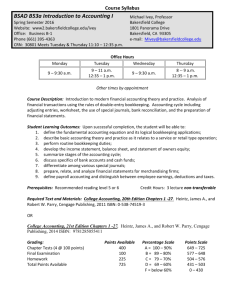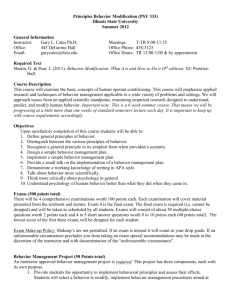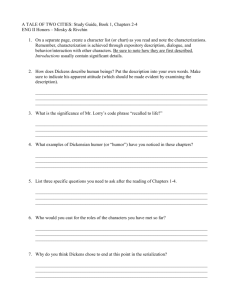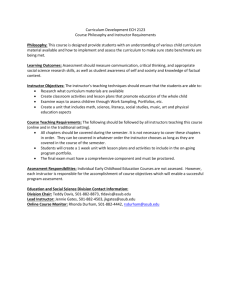Course Objectives - University of Nevada, Las Vegas
advertisement
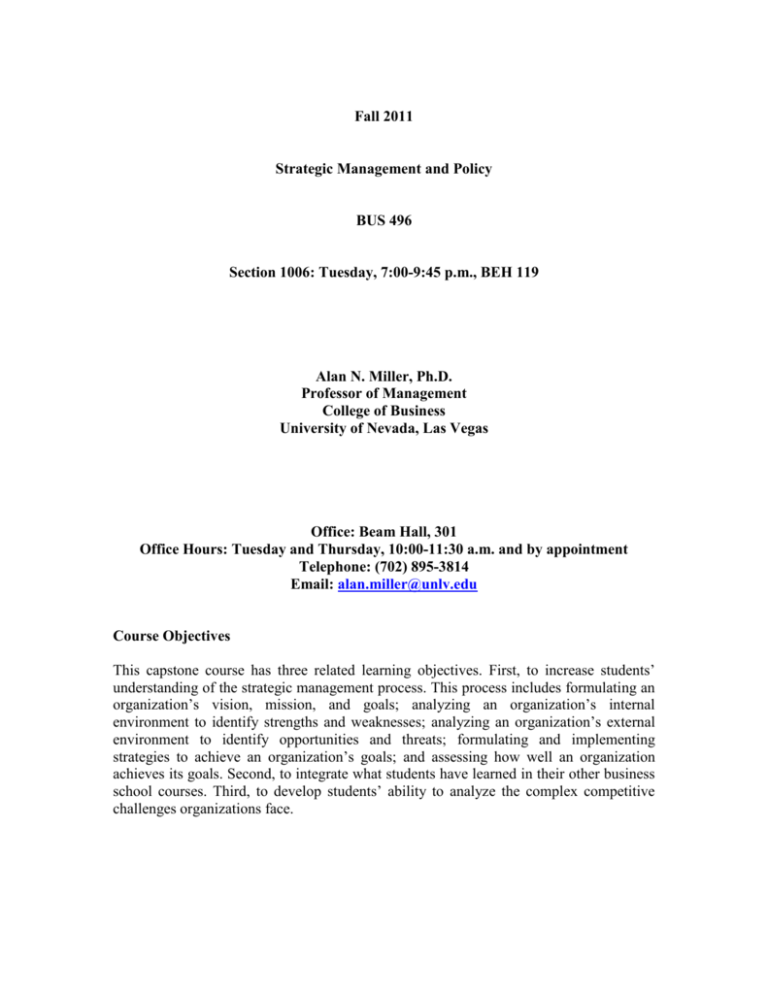
Fall 2011 Strategic Management and Policy BUS 496 Section 1006: Tuesday, 7:00-9:45 p.m., BEH 119 Alan N. Miller, Ph.D. Professor of Management College of Business University of Nevada, Las Vegas Office: Beam Hall, 301 Office Hours: Tuesday and Thursday, 10:00-11:30 a.m. and by appointment Telephone: (702) 895-3814 Email: alan.miller@unlv.edu Course Objectives This capstone course has three related learning objectives. First, to increase students’ understanding of the strategic management process. This process includes formulating an organization’s vision, mission, and goals; analyzing an organization’s internal environment to identify strengths and weaknesses; analyzing an organization’s external environment to identify opportunities and threats; formulating and implementing strategies to achieve an organization’s goals; and assessing how well an organization achieves its goals. Second, to integrate what students have learned in their other business school courses. Third, to develop students’ ability to analyze the complex competitive challenges organizations face. Prerequisites Students must have completed FIN 301 (Principles of Managerial Finance), MGT 301 (Principles of Management and Organizational Behavior), and MKT 301 (Marketing Management); admission to a business major; and junior or higher standing. Required Book David, F. R. (2011). Strategic Management: Concepts (thirteenth edition). Upper Saddle River, NJ: Prentice Hall. Required Cases These cases have been bound in a Xanedu Course Pack that may be purchased at the UNLV Bookstore: Casadesus-Masanell, R., & Aucoin, M. (2010). “Cirque du Soleil – The High-Wire Act of Building Sustainable Partnerships.” Harvard Business School Case 9-709-411. Edelman, B., & Eisenmann, T. R. (2010). “Google Inc.” Harvard Business School Case 9-910-036. Huckman, R. S., & Pisano, G. P. (2010). “JetBlue Airways: Managing Growth.” Harvard Business School Case 9-609-046. Koehn, N. F., Besharov, M., & Miller, K. (2008). “Starbucks Coffee Company in the 21st Century.” Harvard Business School Case 9-808-019. Yoffie, D. B., & Kim, R. (2009). “Gucci Group in 2009.” Harvard Business School Case 9-709-459. Course Requirements and Grading Attendance and punctuality are required at the class meeting on which teams are selected for the Team Project and the class meetings on which examinations are scheduled (see the class schedule below). Attendance and punctuality at all other class meetings are strongly recommended. Students are required to read all assignments (book chapters and cases) before the date they are scheduled to be discussed in class (see the class schedule below). Cases must be brought to class on the date they are to be discussed. There will be four examinations given on the dates shown in the class schedule. The first exam has 40 multiple-choice questions and is worth 40 points. The second and third exams each have 50 multiple-choice questions; each exam is worth 50 points. The final exam has 50 multiple-choice questions and is worth 100 points. The exams cover both 2 assigned readings and class lectures. A brown or green Scan-Tron answer sheet and a number 2 pencil are required for each exam. Make-up exams are only given to students who notify the instructor before missing an exam and who provide an acceptable written excuse that can be documented. On September 6, each student must attend class and join a team. Each team is required to complete the Team Project, a comprehensive strategic analysis of a business. Each team must select a publicly traded company from the most recent Fortune 500 list. The company selected may not be any of the companies listed on the handout of companies that cannot be used for the Team Project. Teams may not select the same company and must provide the instructor with the name of their company by September 13. The instructor must approve the company each team selects. The Team Project requires that each team make an oral presentation to the class on November 22 or 29 (see the class schedule) which describes their company’s vision and mission; evaluates their company’s internal strengths and weaknesses (including an evaluation of the company’s financial performance during the most recent three years, using financial ratios); evaluates their company’s external opportunities and threats; evaluates their company’s business level strategy; and makes recommendations about how their company can solve whatever strategic problems it is facing. Evaluation of the strengths, weaknesses, opportunities, and threats must include how each affects the company’s ability to achieve its vision and mission. The presentation must be between 30 and 35 minutes, must equally involve each team member in both the presentation and its preparation, and must follow the amended steps for presenting an oral case analysis on pages 356-358 of Strategic Management: Concepts (thirteenth edition) by Fred R. David. The use of Power Points is required. Each team must provide the instructor with a hard copy of their Power Points at the time of their presentation. The Team Project is worth 60 points and will be graded on quality of content and analysis (40%), thoroughness (40%), and adherence to the time requirement (20%). The Wall Street Journal (WSJ) is an excellent source of current information about organizations and the strategic management process. Students who subscribe to the WSJ will receive 5 points that will be awarded as extra credit. In order to receive these points, the subscription must begin no later than the fourth class meeting of the current semester; end no earlier than the last class meeting of the semester; and students must give the instructor an Account Status (AS) form from the WSJ by October 4. To obtain an AS form go to www.services.wsj.com and follow the directions. The student’s full name must appear on the AS form. Course Web Site The web site http://faculty.unlv.edu/amiller contains the course syllabus, sample multiple-choice questions that test your understanding of the five required Harvard Business School cases (see page 2 of this syllabus), as well as all the Power Point presentations I will use in my class lectures. To access these click on “Classes” in the left column and then on “BUS 496 – Strategic Management and Policy.” 3 Determination of the Course Grade A student’s course grade is determined by summing the number of points received for all examinations and the Team Project. If applicable, extra credit points for subscribing to the WSJ will be added to this total. The following table shows the number of points needed to receive each letter grade: 276-300 = A 270-275 = A264-269 = B+ 246-263 = B 240-245 = B234-239 = C+ 216-233 = C 210-215 = C204-209 = D+ 186-203 = D 180-185 = D0-179 = F Students who have a documented disability that may require accommodation must contact the Disability Resource Center (DRC) for coordination of services. The DRC is located in the Student Services Complex (SSC), Room 137 (Voice: 895-0866 or TTY: 895-0652). These students must notify the instructor in writing of the accommodation they need by the last day of late registration. Students requesting an accommodation for religious holidays must notify the instructor in writing of the accommodation they need by the last day of late registration. 4 CLASS SCHEDULE August 30: Discussion of course objectives, prerequisites, course requirements and grading, course web site, determination of the course grade, etc. Goals and strategies exercise. What is Strategic Management and What are its Benefits? Reading: David, chapter 1. September 6: Business Vision and Mission. The External Assessment. Reading: David, chapters 2 and 3. Students must join a team for the Team Project. September 13: Internet and Library Resources for the Team Project – Guest Speaker: Patrick Griffis, UNLV Business Librarian. How to Prepare and Present a Case Analysis. Amended Steps for Presenting an Oral Case Analysis (Team Project). Reading: David, pages 346-358. Teams must provide the instructor with the name of their company for the Team Project. September 20: First Exam (covers David, chapters 1, 2, and 3; 75 minutes). The Internal Assessment. Reading: David, chapters 4. September 27: Long-Term Objectives and Strategies. Strategy Analysis and Choice. Reading: David, chapters 5 and 6. October 4: Implementing Strategies: Management and Operations Issues. Implementing Strategies: Marketing, Finance/Accounting, R&D, and MIS Issues. Reading: David, chapters 7 and 8. October 11: Second Exam (covers David, chapters 4, 5, 6, and 7; 75 minutes). Strategy Review, Evaluation, and Control. Reading: David, chapter 9. October 18: Business Ethics, Social Responsibility, and Environmental Sustainability. Global and International Issues. Reading: David, chapters 10 and 11. October 25: Case: “Gucci Group in 2009.” Case: “Cirque du Soleil – The High-Wire Act of Building Sustainable Partnerships.” 5 November 1: Third Exam (covers David, chapters 8, 9, 10, and 11; 75 minutes). November 8: Case: “Google Inc.” November 15: Case: “JetBlue Airways: Managing Growth.” November 22: Team Project Presentations (Teams 1, 2, and 3). November 29: Team Project Presentations (Teams 4, 5, and 6). December 6: Case: “Starbucks Coffee Company in the 21st Century.” College of Business Assessment Exams. December 13: 8:10 p.m. – Final Exam (covers David, chapters 1-11 and all the Required Cases listed on page 2 of this syllabus; 120 minutes). 6


